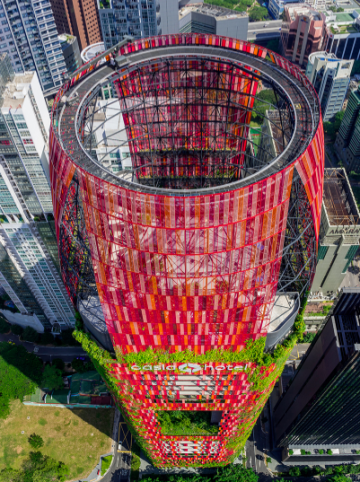How CoxGomyl met the challenge of access solutions for Singapore’s Living Tower
Every building needs practical systems for maintenance and repair. This is commonly for facade cleaning and glass replacement of windows however there is a growing trend for sustainable practices and this is seeing the rise of the building garden. The Oasia Hotel Downtown known locally as the ‘living tower’ in Singapore is an example of such innovation.
In the tropical climate of Singapore, we worked with architects WHOA, who are famous for their integration of environmental and social aspects in their work. For Oasia Hotel they conceived a breath-taking building with an open structure, incorporating four verdant ‘sky terraces’ to serve as urban verandas, sheltered by a sky garden with an open crown instead of a flat roof. The distinctive facade of red aluminium mesh cladding is designed to be home to 21 species of creepers which will grow and fuse with the outside of the building. An additional 33 species of plants and trees have been incorporated into the sky terraces and top level garden. This incredible project is a landmark amongst the traditional high-rise buildings and brings much needed greenery into the CBD, as well as providing a new habitat for birds and animals and increasing urban biodiversity.
Of course, all these unique concepts and architectural features need to be maintained and the building access solutions provided require a parallel level of innovation. In order to preserve the vision of the architects for years to come, BMUs were needed for the maintenance of facade sections, windows and for the pruning and upkeep of all of the vegetation.
Here’s how CoxGomyl rose to the challenge.
For the open crown we designed, built and installed a 5000 Series BMU. The building required a mono-jib F-Type with a 16m jib outreach. This travels along a circular twin track at the crown level. The unique and all important safety feature on this project was the soft-rope system required for the particular architectural challenges of the building. Soft-rope restraint systems allow the BMU to safely travel horizontally or even diagonally. This solution works with the complex design of the building and makes it possible to cross the open voids at intermediate level. This functionality is impossible with traditional gondola systems which could not be properly restrained.
For access at the mid-level sky gardens we also provided monorail systems on the underside of the soffit. Finally, we installed a material hoist crane to service the continued upkeep of this vertical living tower. With three distinct and bespoke access solutions, which all complement the vision of the architects, we are confident the Oasia Hotel can maintain the excellence of this building and ensure people can enjoy the tropical sky garden for years to come!
Back to News